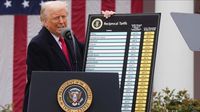In a decision that has sent shockwaves through Washington and the global trade community, the U.S. Court of Appeals for the Federal Circuit ruled on August 29, 2025, that President Donald Trump’s sweeping tariffs on nearly all U.S. trading partners were illegal under the International Emergency Economic Powers Act (IEEPA). The 7-4 ruling upheld an earlier verdict from the U.S. Court of International Trade, which determined that the administration’s justification for the tariffs did not meet the legal definition of a national emergency.
The ruling, however, does not immediately dismantle the tariffs. Instead, it leaves them in place until mid-October, giving the Trump administration a window to appeal to the Supreme Court—a move the president has already vowed to make. As reported by the Associated Press, President Trump responded forcefully on his social media platform, declaring, “If allowed to stand, this Decision would literally destroy the United States of America.”
The contested tariffs, introduced on what the administration dubbed “Liberation Day” in April 2025, imposed rates as high as 50% on countries with which the U.S. runs trade deficits, and a baseline 10% on almost all other imports. Another set, the so-called “trafficking tariffs,” targeted imports from Canada, China, and Mexico, aiming to pressure those nations to curb illegal drug and immigrant flows into the United States. These measures, according to the administration, were justified by long-standing trade deficits and cross-border drug trafficking—issues it declared as national emergencies.
But the court majority was unconvinced. “Both the Trafficking Tariffs and the Reciprocal Tariffs are unbounded in scope, amount, and duration,” the judges wrote, as cited by Council on Foreign Relations. “These tariffs apply to nearly all articles imported into the United States (and, in the case of the Reciprocal Tariffs, apply to almost all countries), impose high rates which are ever-changing and exceed those set out in the [U.S. tariff system], and are not limited in duration.” The judges further noted, “It seems unlikely that Congress intended to … grant the President unlimited authority to impose tariffs.”
White House senior counselor for trade and manufacturing Peter Navarro blasted the ruling as “weaponized partisan injustice,” arguing that the dissenting judges’ support for the tariffs would bolster the administration’s case before the Supreme Court. Navarro insisted that the trade deficit itself is “absolutely devastating to this country” and constitutes an emergency, directly challenging the court’s interpretation. He also pushed back against the notion that the tariffs were permanent, stating on Fox News, “Hey memo to the court: we never said they were permanent.” According to Navarro, the tariffs would be lifted if illegal drug flows from China, Mexico, and Canada ceased or if the trade deficit shrank to zero.
President Trump, for his part, has offered a more nuanced position. In April, when asked whether tariffs could be both permanent and negotiable, he responded, “They can both be true. There could be permanent tariffs, and there could also be negotiations, because there are things that we need beyond tariffs.” In May, he declared that auto tariffs are permanent, but those duties—imposed under a different statute—were not affected by the court’s decision.
Supporters of the court’s decision argue that it reins in presidential power and restores Congress’s constitutional role in setting trade policy. Jeffrey Schwab, director of litigation at the Liberty Justice Center, told the Associated Press, “This decision protects American businesses and consumers from the uncertainty and harm caused by these unlawful tariffs.” Jake Colvin, president of the National Foreign Trade Council, echoed this sentiment, saying, “If these tariffs are ultimately struck down, it ought to serve as a wake up call for Congress to reclaim its constitutional mandate to regulate duties and bring some long-term certainty for U.S. businesses and relief for consumers.”
On the other side, Trump’s allies maintain that the president acted within his legal authority. White House spokesman Kush Desai stated, “We look forward to ultimate victory on this matter.” Attorney General Pam Bondi accused the judges of interfering with the president’s central role in foreign policy and promised to pursue the appeal.
The stakes are undeniably high. The U.S. Treasury has collected $159 billion in tariff revenue as of August 2025, more than double the amount from the previous year. The Justice Department has warned that if the tariffs are invalidated, the government could face massive refund claims, potentially causing “financial ruin” for the Treasury. Trade attorney Ryan Majerus remarked, “For all the tariffs that have been collected under IEEPA, you’re going to see folks request refunds and more refunds.”
The legal battle also casts doubt on several international trade agreements. According to the Council on Foreign Relations, deals with Japan, the European Union, and other partners—negotiated in the wake of the “Liberation Day” tariffs—may now be on shaky ground. If the Supreme Court upholds the lower courts’ decisions, most tariffs introduced under IEEPA this year will be canceled, and the administration could be forced to repay billions in duties.
Other tariffs, such as those imposed on steel, aluminum, and autos under Section 232 of the Trade Expansion Act, remain unaffected by the ruling and could even be expanded. The administration has signaled its intent to pursue additional sectoral tariffs, including on furniture imports, under this authority. Section 122 of the Trade Act of 1974 also allows the president to impose tariffs of up to 15% for 150 days in cases of balance of payments emergencies, but any extension would require congressional approval. Section 301, used during Trump’s first term to target China, remains another possible avenue for imposing tariffs—though it requires a finding of specific unfair trade practices.
For U.S. businesses, the uncertainty has been costly. Many firms have paid billions in tariffs and may now seek rebates if the Supreme Court rules against the administration. Yet, as Brad W. Setser of the Council on Foreign Relations notes, the broader issue is the lack of clarity about which tariffs will endure, discouraging long-term investments and supply chain reconfigurations. “Until there is clarity about which tariffs will stick, most firms will be reluctant to make the large, multiyear investments needed to reconfigure supply chains,” Setser wrote.
The core legal question heading to the Supreme Court is whether Congress intended to delegate such broad tariff authority to the president under IEEPA—a law historically used for financial sanctions rather than trade measures. The lower courts have highlighted that the words “tariff” and “duty” don’t appear in IEEPA, making Trump’s use of the law for tariffs both novel and legally precarious. The dissenting judges, however, argued that the 1977 law was not an unconstitutional delegation of legislative authority, referencing past Supreme Court decisions that have allowed some tariff powers to be granted to the executive branch.
With the Supreme Court likely to rule quickly on this high-stakes challenge, the future of U.S. trade policy—and the balance of power between Congress and the president—hangs in the balance. As the October deadline approaches, businesses, lawmakers, and trading partners around the world are bracing for a decision that could reshape the landscape of American trade for years to come.


